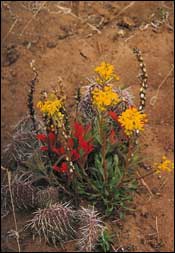![]()
The Full Four Seasons
by Tessa Bielecki
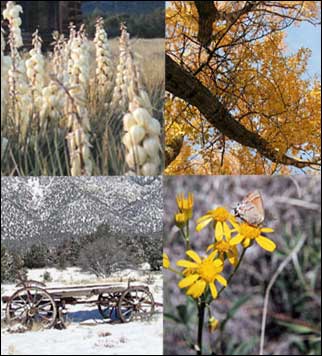
| Summer “Be not just summer to my soul, but the full four seasons.” I heard this poetic verse years ago, perhaps from Shakespeare, though I’ve never found the source. It sounds like part of a sonnet from a lover to his lady. I’ve always understood it as a love song between God and my soul, especially in these last four years, living as a hermit outside the town of Crestone. |
|
Summer is harsh here in the San Luis Valley, a high altitude desert as large as the state of Connecticut where I was born. We get only seven inches of rain a year, sometimes almost all at once in the violent flash floods of summertime which thunder out of the Sangre de Cristo Mountains and send tree trunks and huge boulders down the dry arroyos, eroding the land and leaving people stranded.
|
|
Autumn |
|
Autumn is both magical and melancholy in Crestone with aspens gold and tangerine at the higher elevations, rabbit brush and cottonwoods bright yellow outside my hermitage and along San Isabel Creek, which I cross every day on my morning walk. In her exquisite poem, “In Blackwater Woods,” Mary Oliver describes autumn as a season of trees fragrant with cinnamon and fulfillment, as the season of loss and letting go. |
|
|
|
|
Winter |
|
“The best part of winter is snow falling,” writes poet Donald Hall. “The best part of winter is sun on the snow,” he says. “The best part of winter is the full moon on snowfields.” Where I live, you can almost read by the brightness of full moon on snow. “Winter is the year’s pause,” Hall continues. Don’t we all need quiet contemplative pauses in our lives? “The mind of winter studies desolation’s purity, vigor, and strict beauty.” Sounds like contemplative prayer in the desert to me – the snow desert, uniquely beautiful and different from, yet very like the sand desert. I love how we speak of the “dead” of winter. Everything around us not only looks dead, it is dead: bare trees, barren landscape, the iced-over waters of San Isabel Creek which no longer run and gurgle. (Oh! Blessed winter silence!) The nights here are so cold and long, it seems as if the sun is dead, too. |
|
|
Yet, as we learn from the Passover mystery of Crucifixion-Resurrection in the life of Jesus, is anything ever really dead? Winter is “sleeping energy,” like Jesus “sleeping” in the tomb until “the third day.” |
Spring |
|
“May you be blessed forever and ever, my God, for within a moment you undo a soul and remake it,” sang St. Teresa. She frequently describes how well God “repays” us for every suffering. The soul, she says, “comes out of the crucible like gold, more refined and purified, so as to see the Lord within itself.”
The predominant color of autumn dying here in the Colorado desert is not blood-red but gold. And the predominant color of revivifying spring is not green but yellow-green: the color of young cottonwood buds coming up the creek from the valley floor, the color of the first wildflower, the scurf pea, the color of gold, like our souls coming out of the crucible of whatever winter, whatever loss and death we have endured. The Full Four Seasons
|
|
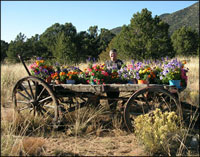
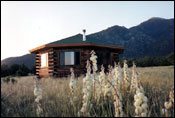 Our
relationship with God can be like
that: sometimes a dry well, when
the bucket comes up empty, and then
a gushing river. At one point in
her life, St. Teresa of Avila wrote:
“My soul was left as though
in a desert.” Later she felt
almost drowned “by a great
deal of rain. For the Lord waters
the garden [of our soul] without
any work on our part.” As Isaiah
said, “Waters shall break forth
in the wilderness, and streams in
the desert; the burning sand shall
become a pool, and the thirsty ground
springs of water” (35:6-8).
Our
relationship with God can be like
that: sometimes a dry well, when
the bucket comes up empty, and then
a gushing river. At one point in
her life, St. Teresa of Avila wrote:
“My soul was left as though
in a desert.” Later she felt
almost drowned “by a great
deal of rain. For the Lord waters
the garden [of our soul] without
any work on our part.” As Isaiah
said, “Waters shall break forth
in the wilderness, and streams in
the desert; the burning sand shall
become a pool, and the thirsty ground
springs of water” (35:6-8).
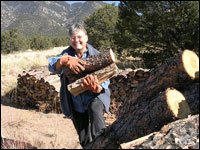
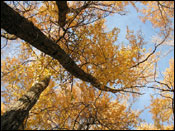
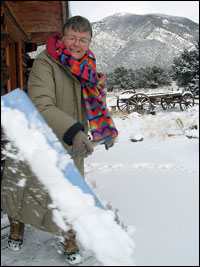
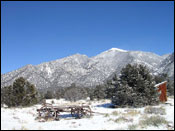
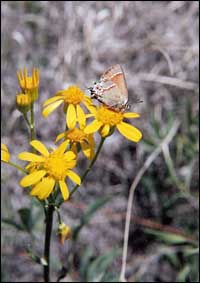 Springtime
is nature’s “third day,”
nature’s Resurrection, and
a mirror of our own. Sooner or later,
one way or another, we all rise from
the dead. The burgeoning green of
springtime reflects our own burgeoning
vitality. Like the land around us,
we burst from the tomb of our winter
as though emerging from a womb. Like
San Isabel Creek, swollen with snowmelt,
we spill beyond our boundaries, life
overflowing, too big and strong to
be contained by any limitation.
Springtime
is nature’s “third day,”
nature’s Resurrection, and
a mirror of our own. Sooner or later,
one way or another, we all rise from
the dead. The burgeoning green of
springtime reflects our own burgeoning
vitality. Like the land around us,
we burst from the tomb of our winter
as though emerging from a womb. Like
San Isabel Creek, swollen with snowmelt,
we spill beyond our boundaries, life
overflowing, too big and strong to
be contained by any limitation.